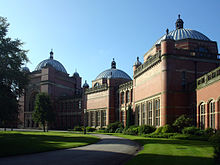
Back الانتقائية في العمارة Arabic Memarlıqda eklektizm Azerbaijani Эклектыка (архітэктура) Byelorussian Эклектыка (архітэктура) BE-X-OLD Arquitectura eclèctica Catalan Eklekticismus (architektura) Czech Εκλεκτικισμός (αρχιτεκτονική) Greek Eklektika arkitekturo Esperanto Arquitectura ecléctica Spanish Arkitektura eklektikoa Basque
This article needs additional citations for verification. (May 2022) |


Eclecticism in architecture is a 19th and 20th century architectural style in which a single piece of work incorporates eclecticism, a mixture of elements from previous historical styles to create something that is new and original. In architecture and interior design, these elements may include structural features, furniture, decorative motives, distinct historical ornament, traditional cultural motifs or styles from other countries, with the mixture usually chosen based on its suitability to the project and overall aesthetic value.
The term is also used of the many architects of the 19th and early 20th centuries who designed buildings in a variety of styles according to the wishes of their clients, or their own. The styles were typically revivalist, and each building might be mostly or entirely consistent within the style selected, or itself an eclectic mixture. Gothic Revival architecture, especially in churches, was most likely to strive for a relatively "pure" revival style from a particular medieval period and region, while other revived styles such as Neoclassical, Baroque, Palazzo style, Jacobethan, Romanesque and many others were likely to be treated more freely.


- ^ Whittick, A, 1974. European Architecture in the Twentieth Century. 1st ed. New York: Leonard Hill Books. pp. 17–27.